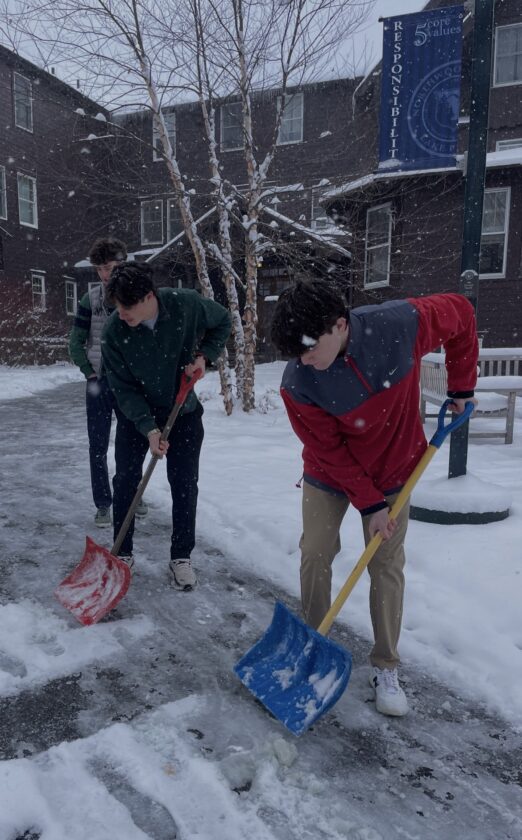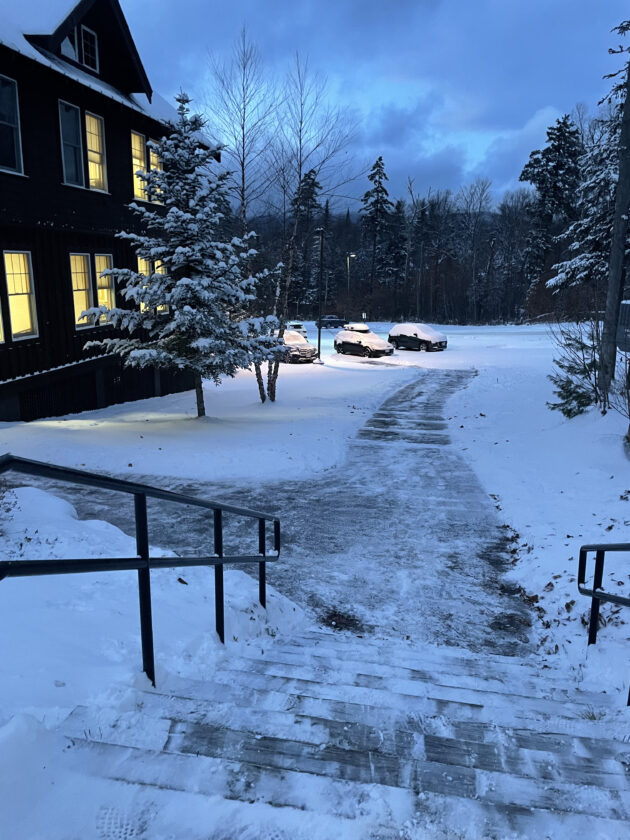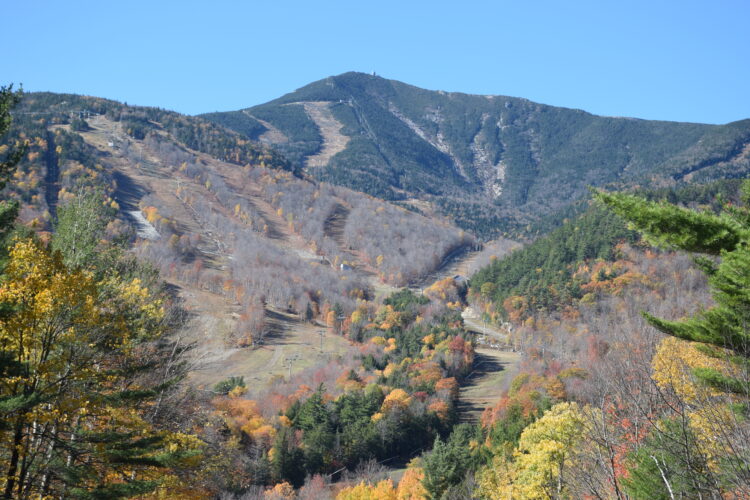Northwood School continues effort that cut campus road salt use 75%

Photo Provided by Marcy Fagan Northwood students smile after shoveling walkways on Tuesday, Nov. 11. From left are Devin Smith, Adam Sherman, Henry Kess and Hunter Bridges. The shoveling teams are part of the school’s effort to reduce salt use by coordinating a “rapid response” to clear snowfall soon after it falls. This avoids it binding to the surface, and means that significantly less salt needs to be used to maintain safe walkways. The school reduced its salt use by 75% in 2024 -- the program’s pilot year -- as compared to 2023.
LAKE PLACID — The Northwood School is taking a hands-on approach to reducing salt use — literally.
The school is entering its second year of using a coordinated “rapid response” system for shoveling and plowing snowfall as close as possible to when it stops falling. Students work in teams to shovel and clear walkways near dormitories, while grounds staff oversee larger clearing areas, such as parking lots.
The effort has made a massive dent in the amount of salt the school needs to keep its campus safe throughout the winter.
Put simply, that’s because not all shoveling is the same. The timing of when it gets done, relative to the snowfall, can make a huge difference in its efficacy, and ultimately, the amount of salt that is needed to effectively treat surfaces, Northwood science teacher Marcy Fagan explained.
As snow falls and compacts, it begins binding to surfaces and turning into ice. The longer it’s left, the more difficult, and the less of it gets cleared. This usually means that more salt has to be applied to melt through the stubborn surface ice and render it safe for walking or driving.

Photo Provided by Marcy Fagan Edouard Laberge, left, and Elliot Murch shovel snow at Northwood School on Tuesday, Nov. 11. The student shoveling teams are part of the school’s efforts to reduce the amount of salt it uses for winter surface treatment.
Less is more when it comes to salt. Though it’s often an essential tool for winter safety, not only does reducing its use save money while getting the job done, but using more than needed is problematic. Salt is corrosive and has been proven to have adverse health and environmental impacts when it leeches into the soil, groundwater water and surface water. Fagan also chairs the Mirror Lake Watershed Association, a nonprofit conservation group dedicated to safeguarding the health of Mirror Lake and its watershed.
“I thought, maybe we could get Northwood to be a pilot program for reducing salt use, since we’re so close to the lake and we’re just uphill from the lake — and everything flows downhill,” she said.
Fagan credited much of the idea to Marie McMahon, who co-owns Fire Side Wood, LLC, a local property maintenance, caretaking and firewood business. McMahon realized that her business was often oversalting and took steps to reduce its application. She attended a Mirror Lake Watershed Association meeting, as one of that group’s largest concerns is reducing salt use in the watershed.
That’s where McMahon connected with Fagan and offered to join in on several of her Adirondack Sciences classes, where she could educate students on ways they could become active participants in reducing road salt.
It was a no-brainer, Fagan said. McMahon came three times, teaching students various ways to reduce the need for salt while maintaining safe surfaces. These included the use of segmented plows, pre-treatment brine application and, most directly impactful for boarding students there, the difference that quick shoveling can make.

Photo Provided by Marcy Fagan Shoveled walkways are seen at the Northwood School in Lake Placid on Tuesday, Nov. 11. They were cleared by students as part of a coordinated “rapid response” program the school implemented to reduce its salt use in the winter to treat surfaces. Removing the snow shortly after it falls prevents it from binding to the surface, ultimately requiring less salt to be used to make for a safe surface. Northwood reduced its salt use by 75% in 2024 -- the program’s pilot year -- as compared to 2023.
They devised a plan last year and stuck to it. Students formed four- to five-person teams, and rotated who was “on call” to shovel assigned walkways after each snowfall. Fagan paid close attention to the weather and gave teams advanced notice of when they would be needed. During heavier snowfalls, she readied reinforcements, doubling up on teams to make sure the jobs got done.
At the same time, Northwood Buildings and Grounds Supervisor Scott Gregware and his crew took a similar approach to the larger areas — clearing snow as soon as possible, pre-treating with brine and not oversalting, while maintaining safe surfaces.
“He’s been very open and supportive of the students and reducing salt on campus,” Fagan said. “Last week, he tried using brine to retreat before last week’s storm, and he said it worked really well.”
Last year’s efforts by students and staff reduced salt use by 75% at Northwood, going from about one ton in 2023 to less than 500 pounds last year, according to Fagan — 1,500 or so fewer pounds kept out of the watershed.
“The goal is obviously reducing the salt in Mirror Lake, but it’s also experiential learning for the kids,” she said.
Fagan added that some of the students have never seen snow, much less shoveled it, before attending Northwood. What may come as an obvious task to people who’ve grown up in cold climates is a learning experience, starting from ground zero, for students who grew up in distant latitudes. Fagan said that makes teaching about shoveling, and salt, all the more fun.
One of the Adirondack Sciences class topics is the ecologically harmful effects of salt runoff in the Adirondacks, with Mirror Lake being one of the saltiest waterbodies in the parks, along with the Cascade lakes and Lake Colby. It’s not a coincidence. Mirror Lake is one of the most developed in the park, and the others are adjacent to state highways.
Concerted salt reduction efforts over the past few years, however, have started to turn the tables on Mirror Lake, and scientists have come to view it as a success story in progress. A News article on that is available at tinyurl.com/5n7tcxam.
Besides the science, Fagan said the class, and experiential learning more broadly, also teach students how to use their knowledge to make a real-world impact, even if it’s at the local level.
“If we can use the brine successfully this winter, and even get hand sprayers for the kids to pretreat their dorm entrances, then I’m hoping that they can go then present to the town and talk about the project,” she said.
Beyond the ecological impacts, Fagan said the salt reduction has been successful in saving money and preventing corrosion in dorm rooms, hallways and door frames that are less coated in salt each winter.
“My hope, as a teacher, is to give these kids some real-world experience of, ‘OK, you just learned something and you’re helping an environmental cause, you’re also helping save money and you’re helping on maintenance costs,'” she said. “There are a lot of good things that come out of not using so much salt and we’re hoping that the kids can present that information.”


